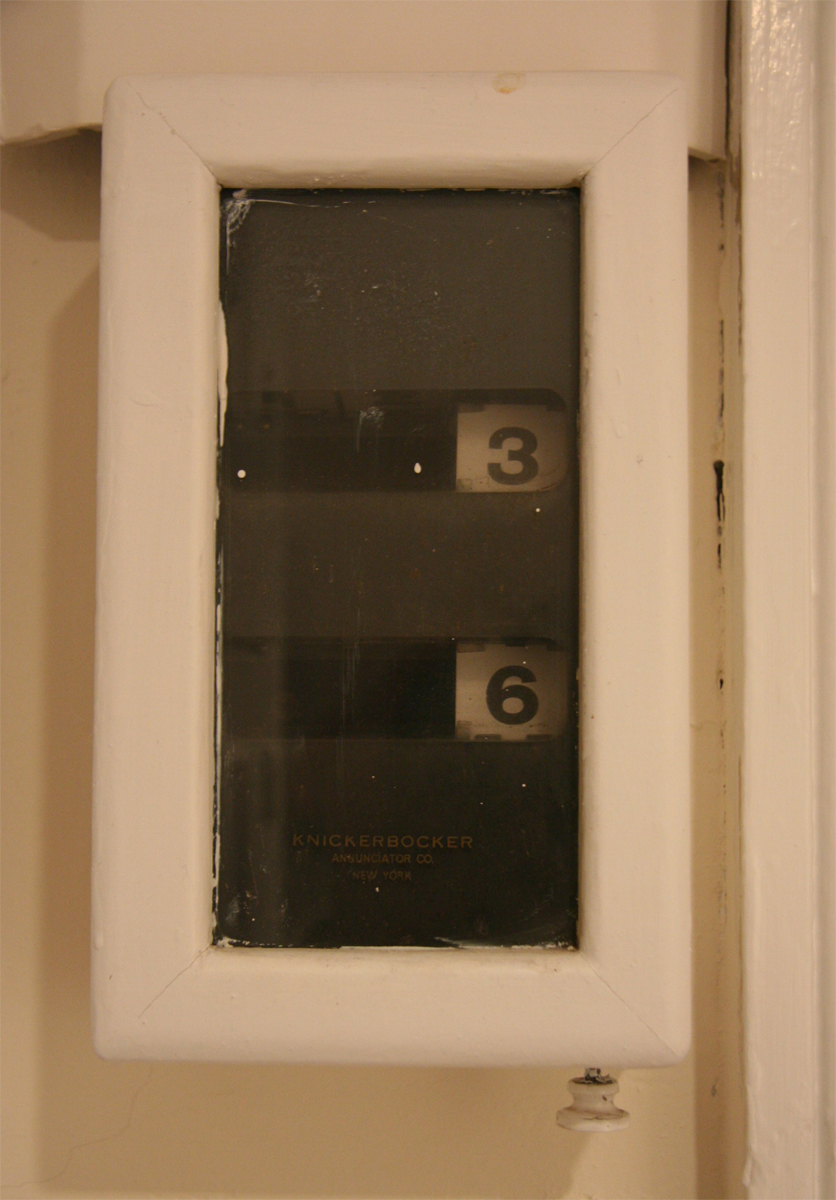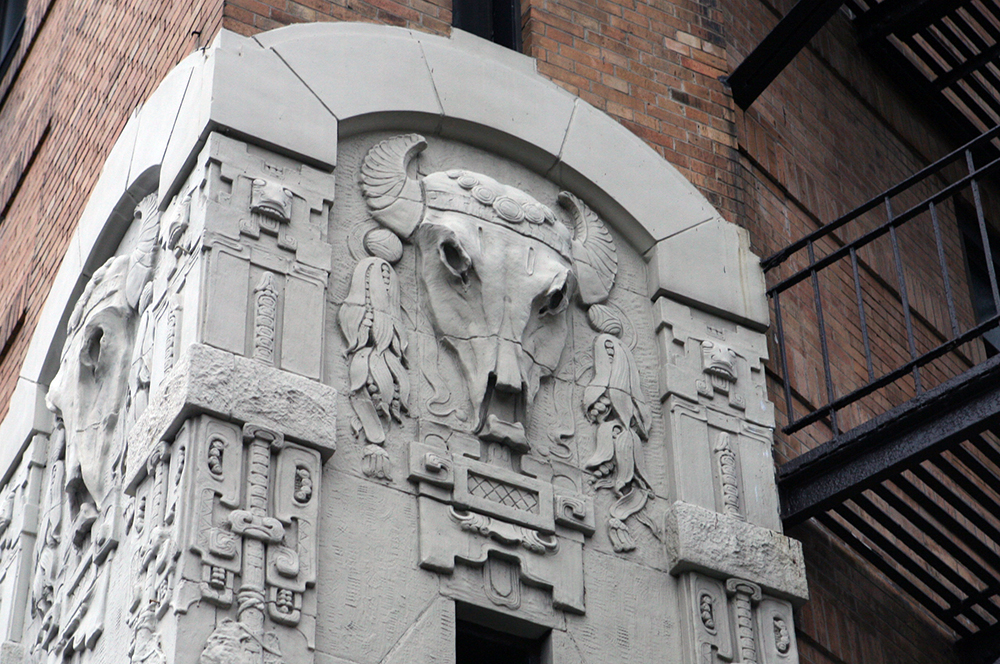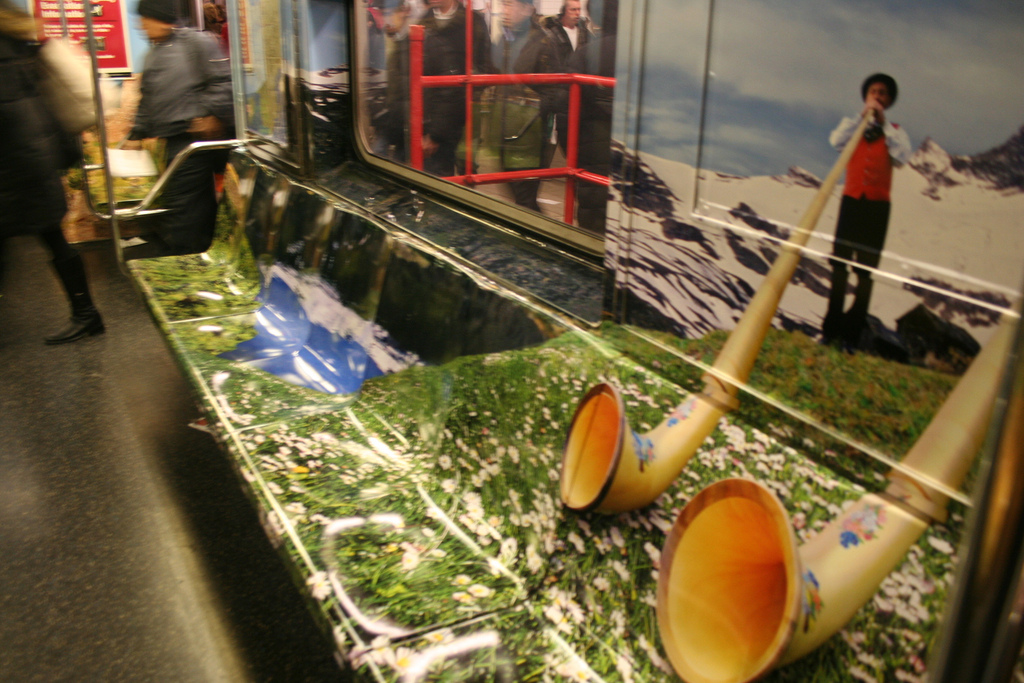The Annunciator Box
A few weeks ago, I was working on a shoot in an amazing 100+ year-old mansion in Long Island. In the hallway leading from the dining room into the kitchen, I noticed something on the wall near the butler’s pantry…
This glass-covered box:
Later, I was in the living room…
…And noticed this button on the wall.
Of course, I couldn’t resist…
Immediately, I heard a loud noise in the kitchen. Turns out, this is the original call system for servants. Press a button, and in the kitchen, a buzzer goes off and a number drops indicating which room is in need of assistance (below, I had pressed the living room button, as well as an upstairs bedroom):
Though broken for years, the new owner recently rewired it back into working condition for fun. There’s a button in each of the downstairs rooms as well as the bedrooms…But for some reason, I couldn’t find one in the dining room.
Turns out, it’s a foot pedal located on the floor beneath the table (currently covered by the rug). A host or hostess could signal for servants without ever leaving the table!
The device was made by the “Knickerbocker Annunciator Co.,” which is a pretty great company name for this sort of thing. A quick Google search reveals their business address at 116 West Street in Manhattan in 1921.
To reset the numbers, you just turn the knob below…
And they crank up into the box!
-SCOUT


















Wowsies!
I especially like the subtle under the mat signal.
To you, your blog is called “Scouting New York”, to me “One thousand a one million reasons to move to New York” (from Australia… ah to dream).
My uncle and aunt had such a system. As young children we were utterly mystified how the servants knew exactly when to come into the dining room as we finished each course.
Even more interesting is that the company seems to have been around in at least somewhat recent history:
Via NY Times October 16, 1983. Wonder if they were still making these things in the 80’s?
My husband is a private chef – one of his clients lives in a historic mansion and has a still-operable annunciator, although he only has it hooked up between the dining room and the butler’s pantry/kitchen. As you pointed out…it’s loud.
Wow that’s a pretty awesome find. Is that company still alive? I wonder what they would make today…
It’s too bad it looks like it was covered with layers of white paint.
There’s one in the Governor’s Mansion in NC. It is located on the underside of the dining room table at the end where the governor sits.
Oh GAWD that is cool- I so need one of those! wonder if it can get here by christmas…
There’s a great old New Yorker cartoon that shows a somewhat tipsy hostess half under the table in her attempt to find the call button with her foot….I’ll have to see if I can find it and link to it.
What a great find!
You might have one of the best jobs ever 🙂
That is awesome!
that is amazing
Very cool – the house I grew up in had buttons like that in many rooms and we always wondered what they did, now we know! Thanks!
My paternal grandparents met as servants in a house like that on Long Island in the 1930s. Very cool.
Excellent post. Really enjoyed this one. Scout, you have all the fun!
I have one of these I picked up at a yard sale on Beacon Hill in Boston. It isn’t “digital” like this one, instead there are little metal arrows that turned to point to the number of the room. A bell at the top of the box (unfortunately missing) would ring at the same time. I imagine it came out of one of the houses nearby where I bought it. Its one of the coolest things I’ve ever found for five bucks, although my servants haven’t been quite as appreciative.
Scout, this site is absolutely AWESOME. This is my first comment as I’ve been going through all of the archives. I’m moving to New York some time next year. I’ve always loved the city but never actually lived there. You are doing a phenomenal job documenting all of the wonderful bits and pieces that make the city the amazing place it is. Keep up the excellent work!!
love this! you have the coolest gigs.
My grandparents’ house had a button under the carpet in the dining room to call the maid. I can remember my grandmother slowly sinking in her chair as she was trying to search for the button. Naturally, we kids instantly dove under the table, found it and started pressing it like mad. It did not please the maid.
Years later when my parents took the house, we insisted they keep the buzzer. It necessitated some changes to their remodel but they did it! They don’t have a maid, but we do occasionally buzz my mom when she’s cooking dinner. She’s always about as pleased as the maid was…
I have a friend who lived in an old “Mill Supervisor” house in Cumberland, RI, which included servant quarters, a butler’s pantry, and a dumbwaiter! I could just imagine being a child and playing in it! she also had a stream running below her house used for fresh water access, located right in the basement!
Here’s a bit more information on Knickerbocker Annunciator in NYC…in the early 80s they were located at 42 Murray Street in lower Manhattan. The were a fabulous place to buy all kinds of wire and cable–we used to buy all our Belden cable from them! Their prices were reasonable and the service was terrific. I don’t know when they closed–they were a great place.
Yours Truly,
Bill Turner
Blue Smoke Band
Really cool find – would never have known there were buttons for that, I only knew about the bell/wire system like in the Merchant House!
The company was last located at 75 Murray Street, Manhattan
we have one nearly identical in nyc. several buttons still working.
the dining room one was probably connected to a small wire in the floor, into which one could connect a portable buzzer small cord covered wire that it connected to. That way, no matter what size the rug, or where the mistress sat she could have the buzzer positioned at her feet.
similar connections were sometimes located in the baseboards in bedrooms so one could connect some kind of connect which ended with a push button that could be located on the bedside table.
some of these were very beautiful, but i have never seen one that survived in its original location…(like looking for the always missing “remote” in todays homes. The buttons located near the doors in rooms weren’t ideal when calling for breakfast, for example. many many large apartments built with servants rooms in nyc in the teens and twenties had these.
also, forgot to say…if you look closely at the floor you might find where in some previous refinishing someone filled the hole and finished it over. What often happened is that the small metal or wood trim around these openings broke or came off over time…and all that was left was a pencil sized hole with some tiny wires jammed inside. but sometimes these wires are still operative in these “annunciator” systems, if you can locate them.
I think the most useful buzzer to have is the floor buzzer, frankly…although I use the others when entertaining….great for cocktails…one can buzz the kitchen inobtrusively and quietly to ask for more drinks, or to say put the soup on the table! If you find someone to fix yours send him to me and he can help me get two of mine ooperative which are not. (my box in the kitchen has 8 bells.
The bell-board is not dead. Until a few years ago, I lived in a high-rise condominium building built in 1980 and all of the units had modern, electric servant bell-boards and maid quarters. Each of the rooms had call buttons but we had such a large place that a lot of time was wasted running back and forth between the kitchen and rooms that we installed an Aiphone closed telephone system. However, the bell-board was still used for the exterior doors, dining room and living rooms. Although it was housed in a plastic casing, it worked just like the antique ones with a buzzer and a number dropping in a window. The maids would push a button on the box to reset the number until the next call. So, the Bell-boards (annuciators) still exist but inter-coms are more efficient.
I’ve located three of these things in working order and installed them in my house! Two are ganged together, with 4 flags each, one in an oak case with a bell on top, and has a rotary knob on the side as a reset; the other made to be recessed with a square chrome cover, with a buzzer in it, having a pushbutton reset. The other has three flags, an oak case, and a knob you bump upward to reset, with no internal signal sound. They’re all made by Edwards, which later made door chimes, and they were all pretty easy to install using 16-volt doorbell transformers. Anybody trying to hook one up can contact me at jcefoundit@gmail.com and I’ll send them some instructions and details. The floor calls were sometimes buttons, but were also sometimes a brass flower-shaped plate separated by an insulator from a lower plate, so that pressure anywhere on the thing made contact. There were also pushbuttons hung on a cord, imitating the older pull-rope3s for mechanical bell servant calls, and the Faberge company made a whole lot of very expensive annunciator buttons (search “Faberge bell push.”)
My grandmother bought a house in Poughkeepsie that was a model home built just before the crash in ’29. Sponsored in part by the local utility it was all electric and had the first instance ‘double throw light switches’ that allowed turning on the light at one end of the hall and turning it off from another switch. And of course it had a Knickebocker Annunciator with buttons in every room. At Christmas dinner my father always threatened no dessert for any of the kids who slipped a foot over to press the hostess button. I manipulated a yardstick with my foot and buzzed in from 3 chairs away which fired up my dad and horrified the adjacent cousins.
This feature definitely comes in handy especially
if you are trying to trim down your weight. After
you’ve just completed a strenuous workout – unless you’re measuring pre and post-workout
hydration levels. Folks of all ages are finally realizing that in order for them to
take the next step forward in having a good life requires their taking
responsibility for how they feel.
This post, while excellent, restricts the definition and use of “annunciator” to a sole particular one. In fact, any device that announces one’s presence is called an annunciator. Sometimes one steps on a mat and a chime sounds. Sometimes opening a door to a shop causes a small bell attached to the door to ring. Sometimes one’s body breaks a light beam to indicate that he/she has entered. There is also a broader definition of annunciator that includes police call boxes, baby monitors, alerts of malfunction in machinery and digital equipment, and the like.